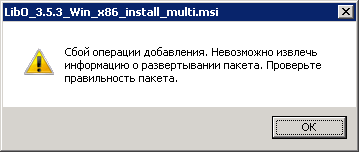LibreOffice in the corporate sector - from theory to practice
LibreOffice in the corporate sector - ready to start
There is such a good article on Habré by frozer , which deals with deployment (using Active Directory) and using LibreOffice (LO) in a corporate environment.
The only minus of the article is only a theoretical approach. Those. The author describes what can be done for LO corporate integration, but the practical part is missing as such.
I tried to learn secrets and get tips on the official Russian-language forum LO, and this is what I received in response:
There is the most effective way.This is clearly not the method. There is also very little information on the Internet, so we will fill in the blanks.
Compile from the source for themselves. Or pay the one who does it.
')
Instructions - under the cut.
Tools
To edit msi-packages we need the appropriate tool. Here we have a choice, use Orca from the Windows SDK from Microsoft, or look for alternatives. There are quite a few free editors with the necessary capabilities, but for myself I found InstEd . The possibilities of the free version for our needs will be enough in full.
Preparing for deployment in AD
So, we have the latest version of msi LibreOffice (at the moment - 4.0.2). There is no way to deploy it through GPO in AD, we will be overtaken by an error at the stage of adding a package to the policy:

The benefit of information to solve this problem on the Internet is. And the bug still hangs, though with the NOTOURBUG status (not our problems, gentlemen).
And this is solved all very simply: open msi in the editor (I will take InstEd as an example), then in the Tables menu - Summary Info ... and in the Languages field we see a sheet from various languages in the form of their codes. We also need to reduce it, so we remove all unnecessary, leaving for example only Russian and English (1033, 1049).
Save the changes and move on.
In principle, you can now deploy LO, although on client machines we will get an installed office suite with a bunch of languages, extensions, a “quick start” enabled by automatic updating. Watching such a zoo is quite difficult.
Get rid of unnecessary, leaving the right
In our organization, we adhere to the following LO setup plan:
- Delete all unnecessary languages, excluding Russian and English.
- Remove all extensions, dictionaries for all languages except Russian and English.
- Disable automatic updates.
- Disable "quick start".
- Disable file preview extension in explorer.
- Associate Microsoft Office file types with LO.
A bit of explanation:
- I consider automatic updating in the AD environment not very necessary, since dispersion of versions on client PCs will cause only chaos.
- We disable the quick start, because the computers are rather weak, it makes no sense to hammer autoloading with unnecessary points.
- Expansion of the conductor is disabled, because there is a bug when the explorer crashes when you try to preview some files.
The remaining points, I think, need not be explained.
I do not urge you to adhere to the same plan, here it is considered rather as a model.
We remove unnecessary languages
Open the msi package, go to the Feature table and look in the Feature column for all the values matching the gm_Langpack_ pattern, which is further divided into several:
gm_Langpack_Basis_
gm_Langpack_Brand_
gm_Langpack_Calc_
gm_Langpack_Draw_
gm_Langpack_Fonts_
gm_Langpack_Impress_
gm_Langpack_Math_
gm_Langpack_Resources_
gm_Langpack_Writer_
gm_Langpack_r_
at the end of each of the values is the designation of the language, for example gm_Langpack_Math_uz or gm_Langpack_Math_uk.
Here you can immediately remove unnecessary help files, the value gm_Helppack_Help_ with the language code at the end is responsible for this.
There are a lot of values, and for each of them you need to change the value in the Level column to 200 (do not set). To save time, at the end of the post I will attach a transformation file with already corrected values.
Remove dictionaries
Similarly with languages, we look for the parameters gm_r_ex_Dictionary_ with the language code at the end in the Feature table.
Remove extensions
Similarly, we look for the gm_o_Extensions_ parameters in the Feature table with the extension designation. Here you can turn off the choice.
Remove Windows Explorer Extensions
Table Feature parameters gm_o_Winexplorerext and gm_o_Winexplorerext_x64 .
Turning off the "quick start"
Open the CheckBox table, and change the value of the QUICKSTART parameter in the Value column to 0. Thus, we will disable the quick start on the root.
Disable automatic update
Open the Property table, look for the ISCHECKFORPRODUCTUPDATES value, set the value to 0.
In the Feature table, look for the gm_o_Onlineupdate parameter, set the Level to 200.
Matching Microsoft Office File Types with LO
Open the Property table, look for the REGISTER_ALL_MSO_TYPES value, set the value to 1. Optionally, you can fine-tune the mapping for each file type separately.
Making a "transformer"
To save time in the future, I recommend saving all changes to a transformation file. In the future, it can simply be applied to the following (preferably minor) LO releases.
In InstEd, this is done like this: before changing any parameters, go to the Transform menu - New Transform and save the future transformation file. After the changes do not forget to save it.
Total
We save our package, create a distribution policy in AD and watch the process.
According to my calculations, the installation (with the removal of the old version) of LibreOffice 4 on a medium-sized PC (2 cores, 2Gb RAM, HDD, KES 10) takes 10 minutes for Windows XP and 3-4 minutes for Windows 7. The installed LO takes ~ 280Mb.
Applications
As promised, I attach the finished transformation file according to the sounded plan.
Links
When writing a post, the following sources were used:
Blog "sysadmin hard work . "
WebGNUru website
Wiki opennet
Source: https://habr.com/ru/post/175991/
All Articles